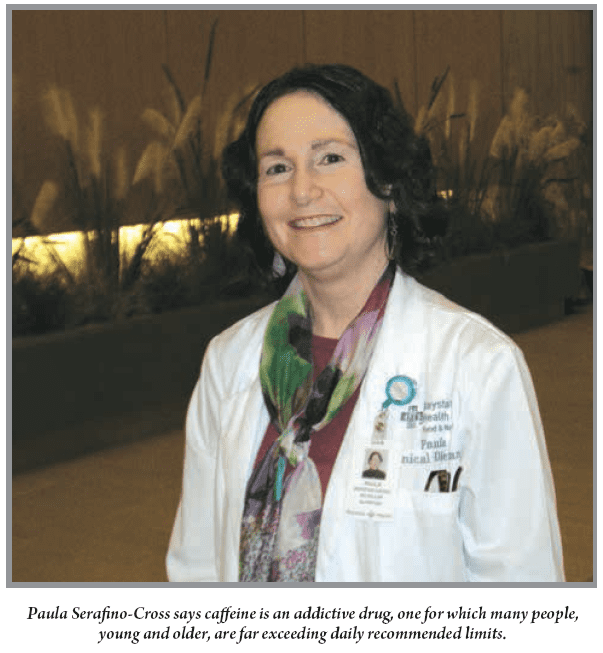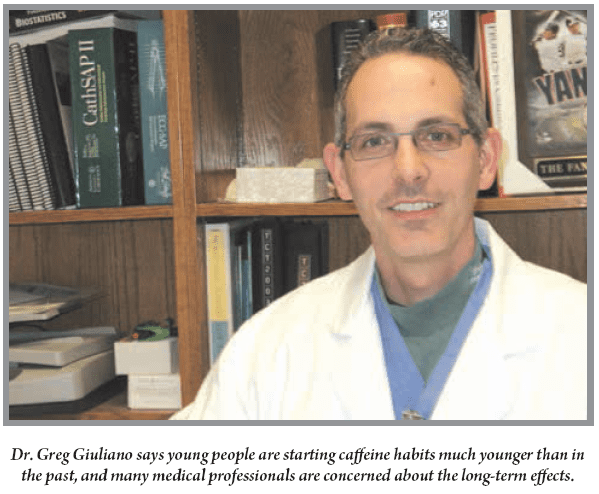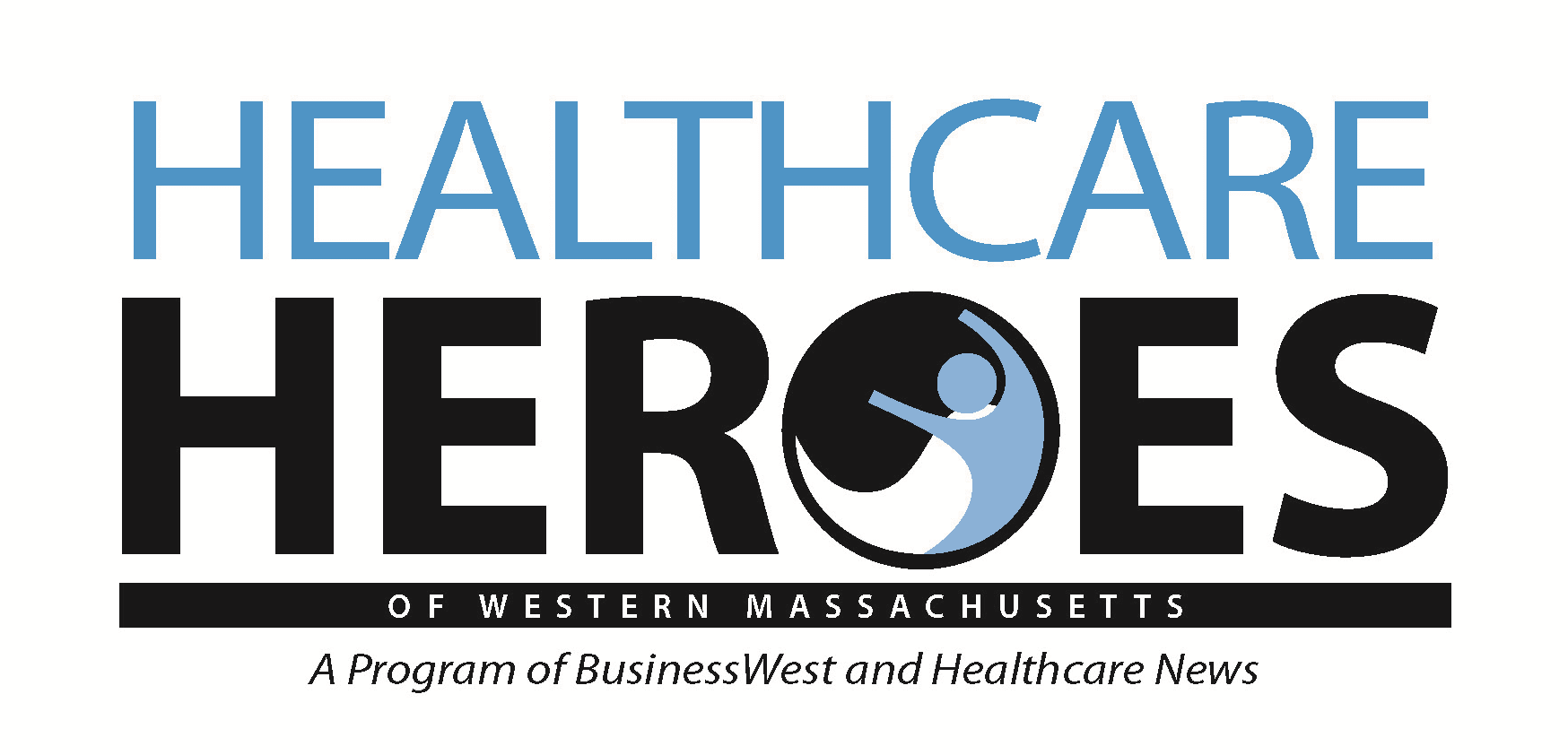Shock to the System
Energy Drinks Continue to Spur Health Concerns
As someone who studies nutrition— but also someone who spends much of his day around young people —Richard Wood is concerned.
“Just from my standpoint, looking around as a bystander among college students … energy drinks are rampant,”said Wood, assistant professor of Exercise Science at Springfield College.“When I come to my class on any given day, a third of them are sitting therewith some sort of energy drink. I guess it’s part of the culture, but these are chemicals; people use this in place of coffee, especially the younger generation.”
He is n’t alone in making the observation that energy drinks— among them popular brands such as Red Bull,Monster, Rockstar, and Full Throttle,not to mention smaller but equally potent ‘shots’ like 5-hour Energy —have become as common for teens and college students as that daily morningcoffee is for adults.
“I drink coffee every day,” said PaulaSerafino-Cross, a clinical dietitian with Baystate Health. “For the younger generation, this is their coffee.”
And many young people honestly feel like they need that caffeine boost,she added. “I do think people are trying to pack in a lot more in less time, and they’re sleep-deprived. Is it because they’re doing more academically? Are they spending more time late at night on the computer, not getting enough sleep?
“Caffeine is an addictive drug,” she went on. “We don’t think of it as a drug, but it is; the more kids take it, the more they need it.”

But now, there may more cause for concern. According to the Drug Abuse Warning Network (DAWN), a program of the federal government’s Substance Abuse and Mental Health Services Administration, the number of emergency- room visits involving energy drinks more than doubled from 10,068 visits in 2007 to 20,783 visits in 2011.
Most of those visits fall under the category of ‘adverse reactions,’ meaning anything from elevated heart rate to anxiety to seizures, while others stem from misuse of caffeinated drinks in combination with alcohol or other drugs (more on that later). A small number of deaths have been linked to Monster, Rockstar, and 5-hour Energy, according to the U.S. Food and Drug Administration.
In response, the FDA launched an official investigation last fall into the safety of energy drinks containing caffeine and other stimulants and may require regulatory action if evidence of a health risk is found.
What may be most concerning, doctors say, is that no one really knows what the long-term effects are of these caffeine-spiked, often-sugar-laden beverages.
“Some of the medical issues have been uncovered,” said Dr. Gregory Giugliano, an interventional cardiologist at Baystate Medical Center, who cited, as one example, underlying asymptomatic heart arrhythmias, which can suddenly become symptomatic in the presence of excessive caffeine.
“Many of these drinks can have longterm effects in terms of how caffeine is linked to heart rate and blood-pressure increase,” he continued. “We normally think your morning coffee affects you for only a couple of hours, but with some of these drinks, the effect can last over a week, as far as maintaining elevated blood pressure and heart rate. They also come in much larger volumes than a can of Coke.”
One of the concerns, said those who spoke with HCN, is the fact that an energy drink is not classified under U.S. law as a food or drug, which are tested and regulated by the FDA. “It’s classified as a supplement,” Serafino-Cross said. “That means it’s not under the FDA’s jurisdiction … and they don’t have to list the caffeine content.”
What that means, said Giugliano, is that “younger kids have access to it very easily; it’s unregulated. And that’s all before we get to the mixing of these caffeinated beverages with alcohol, has led to another set of problems.”
This month, HCN examines the growing popularity of energy drinks — and the potential risks of loading up with sugar- and caffeine-laden beverages to get through the day.

Wide Awake
For a cardiologist like Giugliano, one major concern is the high levels of caffeine in energy drinks and its effects on the heart. “Many of these drinks are more potent than your average cup of coffee,” he noted. “There are interactions between caffeine and other drugs that may be prescribed to someone, and those interactions can potentially be fatal.”
Serafino-Cross is also concerned about a cycle of fatigue — exacerbated by late nights and electronic gadgetry — that these drinks are contributing to.
“Kids are not getting enough sleep.”
“Kids are not getting enough sleep, and the screen time — the amount of time they’re spending on their phones or computers — is interfering with REM sleep cycles. They’re not getting enough REM sleep, and they’re waking up exhausted,” she explained. “Therefore, they are fatigued, and these drinks are what they’re turning to, instead of getting a good night’s sleep or getting out into the fresh air for some exercise. How about getting some natural energy, by having a banana or a protein shake made with milk, or a natural fruit smoothie?
“But, instead, look what they’re depending on,” she continued. “From a nutritional standpoint, they’re not getting the things that are helpful. How about some organic juice, or milk, or water? And, again, I don’t think enough young people are getting enough exercise. When they’re feeling logy, the best thing to do is get outside, take a walk around. Someone who is too attached to their phone or computer is going to be more tired than people who are playing sports every day after school.”
According to a Jan. 16 report in the Journal of the American Medical Assoc., when young people choose energy drinks instead of natural foods or exercise to get a lift, they also risk irregular heart rate and palpitations, increased heart rate and blood pressure, insomnia and other sleep disturbances, diuresis (increased urine production), and hyperglycemia, or increased blood sugar, which is related to all beverages with high sugar content (more on that later). This can be harmful for individuals with diabetes or other metabolic health problems.
The American Academy of Pediatrics recommends that young children should not consume energy drinks, because caffeine may be especially harmful for children, notes the study’s authors, Drs. Janet Torpy and Edward Livingston.
Meanwhile, “adolescents should not have more than 100 mg of caffeine each day. Parents should monitor how much soda or coffee (or other beverages containing caffeine, including energy drinks of any kind) their teenagers drink and help them understand the risks associated with taking in large amounts of caffeine.”
Yet, check out the caffeine count in the 16-ounce sizes of several popular drinks: Full Throttle, 197 mg; No Fear, 174 mg; Monster and Rockstar, 160 mg each; Red Bull, 152 mg. Meanwhile, some of these drinks come in larger sizes, and many teens and college-age individuals aren’t stopping at one per day. Compare that to the 20-ounce sizes of Coca-Cola (58 mg of caffeine), Dr. Pepper (70 mg), and even Mountain Dew (90 mg).
To be fair, a typical 16-ounce cup of brewed coffee contains about 170 mg of caffeine, but the recommended caffeine limit for most adults, who comprise the larger target audience for coffee, is about 500 mg per day. Of course, Torpy and Livingston note, “individuals who have heart problems, high blood pressure, or trouble sleeping, or who are taking medications, should be careful to limit the amount of caffeine they drink. Older persons may be more sensitive to the effects of caffeine.”
Still, youth culture of a generation ago wasn’t as saturated with coffee as Generation Y is with energy drinks. “I didn’t start drinking coffee until I was well out of medical school,” Giugliano said, “but now you have younger and younger kids drinking caffeinated beverages, and we don’t really know what effects this can have on the younger kids.”
What we do know, he added, is what the JAMA article details about the effects of caffeine on sleep and waking cycles, heart rate, and blood pressure. “Caffeine is a stimulant, and I don’t think chronically using stimulants has any positive benefit for the normal, average person.
“I think that parents need to be aware that their kids can get these and start at a young age,” he continued. “Any 13-year-old kid who has a couple bucks in his pocket can go get one of these, and parents should be aware of that. They should understand that there is a toxic level of caffeine that the body can handle, and how much they can handle, whatever the drink is, is something they should understand.”
Sugar Highs and Lows
But it’s not just caffeine that has some health professionals alarmed.
“From a nutrition perspective, I have some concerns about these drinks,” Wood said. “First, the amount of sugar in them is usually high. We know refined sugars aren’t good for us, so I’m concerned that people are introducing these and probably not removing the sugar from somewhere else in their diet.
“If someone has a Snickers bar every afternoon,” he continued, “and now they introduce a Rockstar in the morning, they’re probably not removing the candy bar in the afternoon; they’re just adding more refined sugar, which is detrimental.”
He is specially concerned with the effect sugar has on the brain — sugar tends to make people hungrier — as well as the balance of sodium in the drinks. “The sodium in there can make us more thirsty, just like soft drinks, which are formulated to encourage more consumption.”
“If someone has a Snickers bar every afternoon, and now they introduce a Rockstar in the morning, they’re probably not removing the candy bar in the afternoon; they’re just adding more refined sugar, which is detrimental.”
Serafino-Cross agreed. “You’re putting in all that caffeine and sugar, and unfortunately, you end up crashing afterward, and the sugar is absorbed.”
She ticked off a number of other common ingredients in energy drinks, from guarana, ginseng, and taurine to B vitamins and phosphoric acid. The verdict, simply put, is still out on the long-term effects of ingesting some of these on a daily basis. “But nobody has a B1 vitamin deficiency; that’s silly,” she said. “And phosphoric acid is not good for the kidneys.”
Ginkgo biloba, another common ingredient, can have cardiac implications, Giuliano noted, while other ingredients, many of which are unregulated, may also be problematic.
He recalled the days before ephedra, an ingredient in many dietary products, was outlawed by the FDA in 2004, in the wake of indicents like the 2003 death of Major League Baseball pitcher Steve Belcher. “Ephedrine is speed. Energy drinks have caffeine. These are all in the same spectrum, and I certainly think it can be dangerous in excess.”
Wood also drew a line between the public’s former use of ephedra with energy drinks today. “We’re all guinea pigs in the world of nutrition. The public doesn’t know what’s going into these drinks; we don’t know a lot about how these react with people’s medication, with other dietary supplements, with people’s medical conditions. It’s a very individual situation, and we forget that a lot of times. What might be safe for some could be very dangerous for others.”
But, perhaps of more concern, in 42{06cf2b9696b159f874511d23dbc893eb1ac83014175ed30550cfff22781411e5} of the 2011 emergency-room visits involving energy drinks, alcohol or other drugs — illegal or prescription — were a factor, while 58{06cf2b9696b159f874511d23dbc893eb1ac83014175ed30550cfff22781411e5} of those patients used energy drinks alone.
“Kids are not just taking one thing; sometimes they’re mixing them with alcohol,” Serafino-Cross said. “They’re taking these caffeine shots, and they’re going out drinking, and it kind of masks the effects of the alcohol. So they’ve got all this caffeine in their system, and they’re driving, not thinking they’re intoxicated — that’s a really lethal combination.”
Giuliano agreed. “Combining these with alcohol has become a popular thing,” he said. “Alcohol is a depressant; if you add a stimulant, you may not realize how much alcohol you’re drinking or the effect of alcohol on you.”
Culture Shock
While he’s concerned about the health effects, Wood can’t help but admire how effectively the energy-drink industry, through savvy marketing, has positioned itself as a go-to product for young people.
“They’ve made the product a piece of people’s lives so seamlessly,” he said, pointing out how advertising and sponsorships have positioned the products, such as Red Bull’s sponsorship of Crashed Ice, an extreme, downhill, sledding-type sport.
“And the X Games is just covered with Monster advertising,” he added. “They’ve done a good job marketing themselves in sports that are exciting and appealing to young people. They see someone do a triple backflip, and the message is, ‘if I have these drinks, I can be full of energy and very focused.’” Added Serafino Cross, “it’s part of the cool culture, and there’s money to be made.”
However, some government bodies are catching on — albeit not in the States. She noted that Canada recently reclassified energy drinks as a food rather than a health supplement, the first step toward enacting regulations as officials see fit.
What consumers need more of, she and others say, is information — and moderation. The alternative is to respond only after tragedy strikes, and that, too, seems to be part of the American culture.
“I remember when ephedra was on the market in weight-loss products — then a baseball player died, and that’s when they took it off the market,” she noted. “It seems like we always have to wait until these adverse effects occur before we change things.”






Comments are closed.